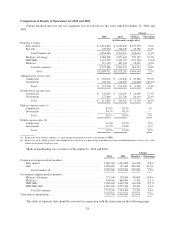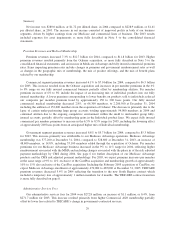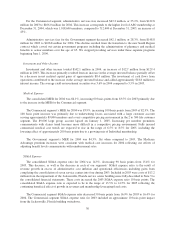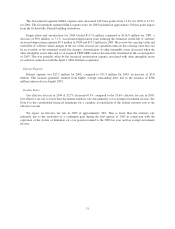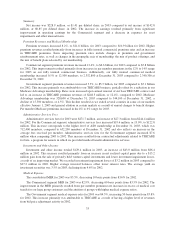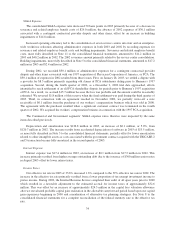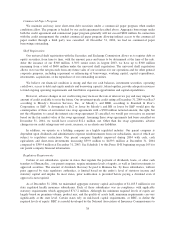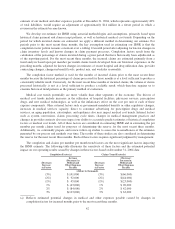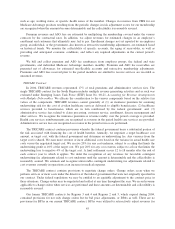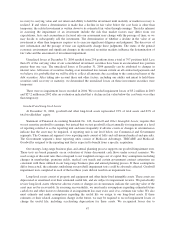Humana 2004 Annual Report Download - page 48
Download and view the complete annual report
Please find page 48 of the 2004 Humana annual report below. You can navigate through the pages in the report by either clicking on the pages listed below, or by using the keyword search tool below to find specific information within the annual report.Commercial Paper Program
We maintain and may issue short-term debt securities under a commercial paper program when market
conditions allow. The program is backed by our credit agreement described above. Aggregate borrowings under
both the credit agreement and commercial paper program generally will not exceed $600 million. In connection
with the credit arrangement, the conduit commercial paper program allowing indirect access to the commercial
paper market through a third party was cancelled. At December 31, 2004, we had no commercial paper
borrowings outstanding.
Shelf Registration
Our universal shelf registration with the Securities and Exchange Commission allows us to register debt or
equity securities, from time to time, with the amount, price and terms to be determined at the time of the sale.
After the issuance of our $300 million, 6.30% senior notes in August 2003, we have up to $300 million
remaining from a total of $600 million under the universal shelf registration. The universal shelf registration
allows us to use the net proceeds from any future sales of our securities for our operations and for other general
corporate purposes, including repayment or refinancing of borrowings, working capital, capital expenditures,
investments, acquisitions, or the repurchase of our outstanding securities.
We believe our financial condition is strong and that our cash balances, investment securities, operating
cash flows, access to debt and equity markets and borrowing capacity, taken together, provide adequate resources
to fund ongoing operating requirements and fund future expansion opportunities and capital expenditures.
However, adverse changes in our credit rating may increase the rate of interest we pay and may impact the
amount of credit available to us in the future. Our investment-grade credit rating at December 31, 2004 was Baa3
according to Moody’s Investors Services, Inc., or Moody’s, and BBB, according to Standard & Poor’s
Corporation, or S&P. A downgrade to Ba2 or lower by Moody’s and BB or lower by S&P would give the
counterparties of three of our interest rate swap agreements with a $300 million notional amount, the right, but
not the obligation, to cancel the interest rate swap agreement. If cancelled, we would pay or receive an amount
based on the fair market value of the swap agreement. Assuming these swap agreements had been cancelled on
December 31, 2004, we would have received $12.1 million, net. Other than the swap agreements, adverse
changes in our credit ratings may not create, increase, or accelerate any liabilities.
In addition, we operate as a holding company in a highly regulated industry. Our parent company is
dependent upon dividends and administrative expense reimbursements from our subsidiaries, most of which are
subject to regulatory restrictions. Our parent company liquidity improved during 2004 with cash, cash
equivalents and short-term investments increasing $39.9 million to $439.3 million at December 31, 2004
compared to $399.4 million at December 31, 2003. See Schedule 1 to this Form 10-K beginning on page 105 for
our parent company financial information.
Regulatory Requirements
Certain of our subsidiaries operate in states that regulate the payment of dividends, loans, or other cash
transfers to Humana Inc., our parent company, require minimum levels of equity, as well as limit investments to
approved securities. The amount of dividends that may be paid to Humana Inc. by these subsidiaries, without
prior approval by state regulatory authorities, is limited based on the entity’s level of statutory income and
statutory capital and surplus. In most states, prior notification is provided before paying a dividend even if
approval is not required.
As of December 31, 2004, we maintained aggregate statutory capital and surplus of $1,185.5 million in our
state regulated health insurance subsidiaries. Each of these subsidiaries was in compliance with applicable
statutory requirements which aggregated $717.2 million. Although the minimum required levels of equity are
largely based on premium volume, product mix, and the quality of assets held, minimum requirements can vary
significantly at the state level. Certain states rely on risk-based capital requirements, or RBC, to define the
required levels of equity. RBC is a model developed by the National Association of Insurance Commissioners to
38


